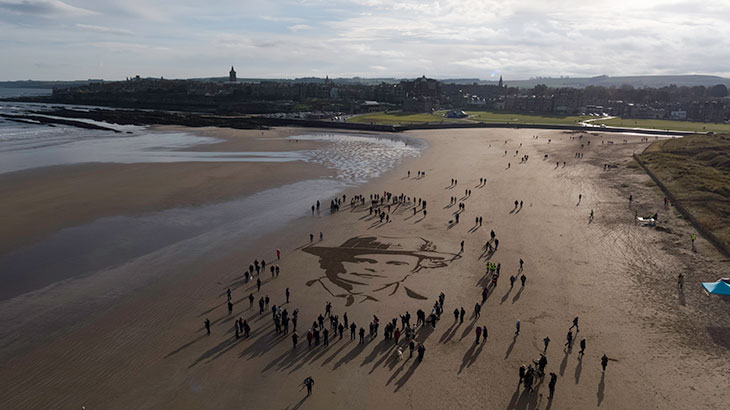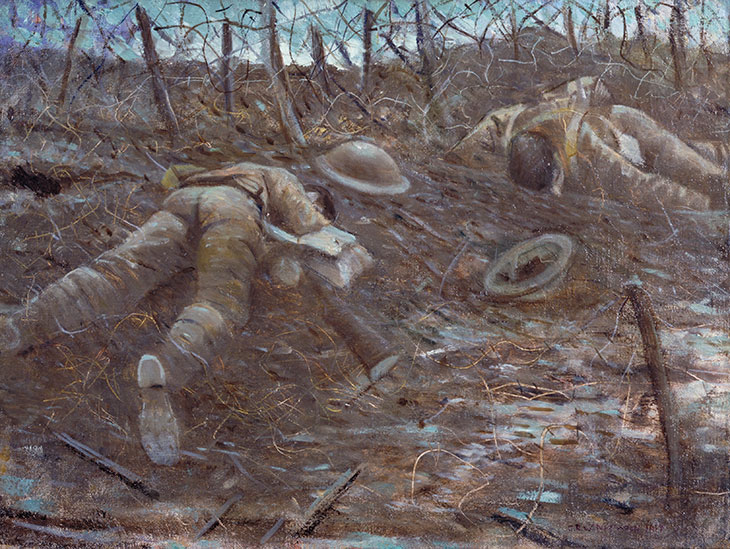Thank heavens the war is over. At least, historically: something of the sense of relief in November 1918 that fighting in the main theatres of war was finally ending is still palpable. As everyone suspected, the centenary of the Great War did capture the public imagination, and this interest was sustained over the 52 months of the commemoration of the conflict.
The cultural events that have claimed the most attention have been the temporary ones: the poppies, spewing from the Tower of London in the installation Blood Swept Lands and Seas of Red in 2014, or Jeremy Deller’s mass re-enactment on the First Day of the Somme centenary in 2016, We’re Here Because We’re Here, in which 1,400 immaculately recreated Tommies silently walked among the public in locations around the UK. This year, Peter Jackson’s documentary They Shall Not Grow Old, assembled from black-and-white archival footage that has been converted to full colour, has made a deep impression. Just the opposite effect was the intention of Danny Boyle’s Pages of the Sea, in which portraits of 32 Great War figures were drawn on 32 beaches, to be devoured by the incoming tide.

Pages of the Sea (2018), Danny Boyle. View of West Sands in St Andrews on 11 November 2018. Courtesy 14–18 NOW
Behind each of these has been the commissioning body 14–18 NOW, which has found imaginative and effective ways to bring something new to the well-worn ways of remembrance. How did that rather more conventional medium, the gallery exhibition, fare? It’s a chequered story.
The centenary started energetically enough. In 2014 the National Portrait Gallery mounted one of the best war exhibitions: ‘The Great War in Portraits’, curated by Paul Moorhouse. Instructive, unfamiliar and even-handed, it included some stand-out novelties such as Colin Gill’s Captain A Jacka, VC, MC and Bar. English Heritage mounted a small display inside the Tardis-like Wellington Arch on ‘London’s Great War Memorials’, heralding the start of four years of heightened conservation effort on these reminders of unprecedented losses. The Fitzwilliam in Cambridge mounted ‘La Grande Guerre: French prints of the First World War’, and Liss Fine Art put on a selling show at Lambeth’s Morley Gallery which successfully demonstrated how high art, propaganda and mass consumption were intertwined.
At the heart of any conversation about remembrance through art in the UK must lie the Imperial War Museum, set up in 1917 with this as one of its core missions. The organisation completed a £40m transformation of its First World War galleries at its flagship location IWM London in time for August 2014, where it mounted a powerful display of its collection in ‘Truth and Memory’, billed as the largest show of First World War art in a century. A version of the show travelled to York City Art Gallery in 2016, where it looked superb. But thereafter, IWM London has, regretfully, shown less art than ever. IWM North in Manchester was the venue for a Wyndham Lewis exhibition in 2017, including major works such as A Battery Shelled (1919). Currently, the venue is host to ‘Lest We Forget?’, a significant and well-received survey of the culture of remembrance, showing until 24 February 2019. It includes many of the large works intended for the Hall of Remembrance, planned but never fully pursued by the Ministry of Information in 1918. The unrealised building is the subject of Moments of Silence, a video installation currently at the IWM London, depicting blueprints crumbling to dust. Created by design and production company 59 Productions, this is one of a number of new installations on the themes of loss and renewal, and there is minimal historical information to hand.
IWM has been commissioning contemporary art since it was founded – but ironically the balance has shifted during the centenary period, away from showing its historical collections towards distinctly variable recent works. As is the case in London’s other major military museum, the National Army Museum – which used to be home to a large gallery devoted to the world wars, vanished in the process of a recent makeover – historical paintings are in retreat.

Paths of Glory (1917), Christopher Richard Wynne Nevinson. Exhibited in ‘Aftermath: Art in the Wake of World War One’ at Tate Britain in 2018. © IWM
Some smaller exhibitions have bucked this trend. Compton Verney in Warwickshire staged ‘Created in Conflict’ this year, devoted to art and craft by soldiers from the Crimean War onwards. Jonathan Black curated the choice display of pilot-artist Sidney Carline’s work at the Estorick Gallery in 2017, and a recent mounting of C.R.W. Nevinson’s prints at the British Museum demonstrated the aptness of this medium at capturing the darkness of war. This emerged also from Tate’s major contribution to the topic: ‘Aftermath: Art in the Wake of World War One’, which ran at Tate Britain from June to September 2018. Refreshingly international in the range of artists included, it began with a ferocious barrage of works created during and immediately after the conflict in its opening rooms, depicting the pity of war and the range of artistic responses it elicited. As the focus shifted towards how the experience of war affected art in the 1920s, the impact inevitably petered out.
The same might be said of centenary exhibitions overall. Nothing has approached the power of Richard Cork’s exhibition ‘A Bitter Truth: Avant-Garde Art and the Great War’, which in 1994 toured in London and Berlin. One hundred years on, remembrance, it seems, has done better on the streets than in the gallery.

The centenary of the Great War is over – but did artists and museums do it justice?
Volunteers dismantling the installation of Blood Swept Lands and Seas of Red at the Tower of London in 2014. Photo: John Stillwell/WPA Pool/Getty Images
Share
Thank heavens the war is over. At least, historically: something of the sense of relief in November 1918 that fighting in the main theatres of war was finally ending is still palpable. As everyone suspected, the centenary of the Great War did capture the public imagination, and this interest was sustained over the 52 months of the commemoration of the conflict.
The cultural events that have claimed the most attention have been the temporary ones: the poppies, spewing from the Tower of London in the installation Blood Swept Lands and Seas of Red in 2014, or Jeremy Deller’s mass re-enactment on the First Day of the Somme centenary in 2016, We’re Here Because We’re Here, in which 1,400 immaculately recreated Tommies silently walked among the public in locations around the UK. This year, Peter Jackson’s documentary They Shall Not Grow Old, assembled from black-and-white archival footage that has been converted to full colour, has made a deep impression. Just the opposite effect was the intention of Danny Boyle’s Pages of the Sea, in which portraits of 32 Great War figures were drawn on 32 beaches, to be devoured by the incoming tide.
Pages of the Sea (2018), Danny Boyle. View of West Sands in St Andrews on 11 November 2018. Courtesy 14–18 NOW
Behind each of these has been the commissioning body 14–18 NOW, which has found imaginative and effective ways to bring something new to the well-worn ways of remembrance. How did that rather more conventional medium, the gallery exhibition, fare? It’s a chequered story.
The centenary started energetically enough. In 2014 the National Portrait Gallery mounted one of the best war exhibitions: ‘The Great War in Portraits’, curated by Paul Moorhouse. Instructive, unfamiliar and even-handed, it included some stand-out novelties such as Colin Gill’s Captain A Jacka, VC, MC and Bar. English Heritage mounted a small display inside the Tardis-like Wellington Arch on ‘London’s Great War Memorials’, heralding the start of four years of heightened conservation effort on these reminders of unprecedented losses. The Fitzwilliam in Cambridge mounted ‘La Grande Guerre: French prints of the First World War’, and Liss Fine Art put on a selling show at Lambeth’s Morley Gallery which successfully demonstrated how high art, propaganda and mass consumption were intertwined.
At the heart of any conversation about remembrance through art in the UK must lie the Imperial War Museum, set up in 1917 with this as one of its core missions. The organisation completed a £40m transformation of its First World War galleries at its flagship location IWM London in time for August 2014, where it mounted a powerful display of its collection in ‘Truth and Memory’, billed as the largest show of First World War art in a century. A version of the show travelled to York City Art Gallery in 2016, where it looked superb. But thereafter, IWM London has, regretfully, shown less art than ever. IWM North in Manchester was the venue for a Wyndham Lewis exhibition in 2017, including major works such as A Battery Shelled (1919). Currently, the venue is host to ‘Lest We Forget?’, a significant and well-received survey of the culture of remembrance, showing until 24 February 2019. It includes many of the large works intended for the Hall of Remembrance, planned but never fully pursued by the Ministry of Information in 1918. The unrealised building is the subject of Moments of Silence, a video installation currently at the IWM London, depicting blueprints crumbling to dust. Created by design and production company 59 Productions, this is one of a number of new installations on the themes of loss and renewal, and there is minimal historical information to hand.
IWM has been commissioning contemporary art since it was founded – but ironically the balance has shifted during the centenary period, away from showing its historical collections towards distinctly variable recent works. As is the case in London’s other major military museum, the National Army Museum – which used to be home to a large gallery devoted to the world wars, vanished in the process of a recent makeover – historical paintings are in retreat.
Paths of Glory (1917), Christopher Richard Wynne Nevinson. Exhibited in ‘Aftermath: Art in the Wake of World War One’ at Tate Britain in 2018. © IWM
Some smaller exhibitions have bucked this trend. Compton Verney in Warwickshire staged ‘Created in Conflict’ this year, devoted to art and craft by soldiers from the Crimean War onwards. Jonathan Black curated the choice display of pilot-artist Sidney Carline’s work at the Estorick Gallery in 2017, and a recent mounting of C.R.W. Nevinson’s prints at the British Museum demonstrated the aptness of this medium at capturing the darkness of war. This emerged also from Tate’s major contribution to the topic: ‘Aftermath: Art in the Wake of World War One’, which ran at Tate Britain from June to September 2018. Refreshingly international in the range of artists included, it began with a ferocious barrage of works created during and immediately after the conflict in its opening rooms, depicting the pity of war and the range of artistic responses it elicited. As the focus shifted towards how the experience of war affected art in the 1920s, the impact inevitably petered out.
The same might be said of centenary exhibitions overall. Nothing has approached the power of Richard Cork’s exhibition ‘A Bitter Truth: Avant-Garde Art and the Great War’, which in 1994 toured in London and Berlin. One hundred years on, remembrance, it seems, has done better on the streets than in the gallery.
Unlimited access from just $16 every 3 months
Subscribe to get unlimited and exclusive access to the top art stories, interviews and exhibition reviews.
Share
Recommended for you
Visions of a dark world in the art of Weimar Germany
The works produced in Germany’s interwar period reflect the turbulence of a decade marked by trauma, hope and crisis
The Apollo podcast: William Kentridge
Thomas Marks talks to William Kentridge about his new performance project, The Head & the Load
Gerry Judah’s First World War memorial for St Paul’s Cathedral
Judah’s sculptures remember all those affected by war throughout the last century